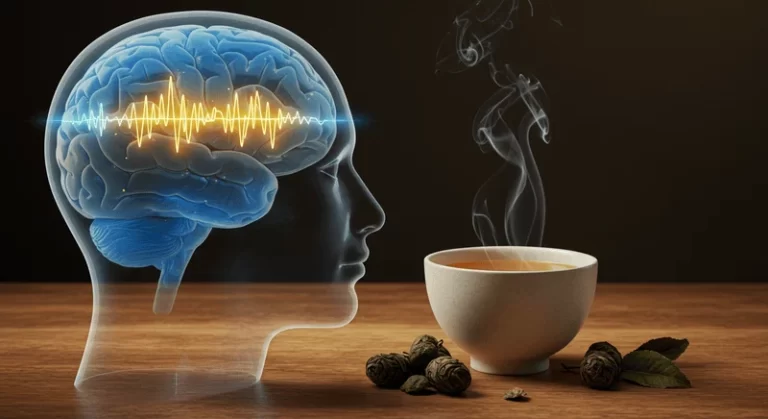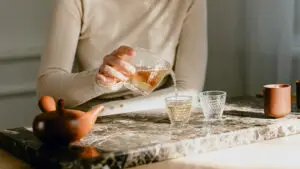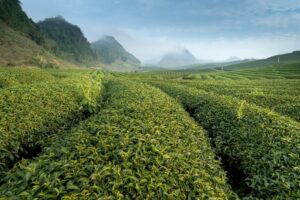In our hyper-connected, fast-paced world, the search for tranquility has become a near-universal quest. We navigate a daily barrage of pressures that can leave our nervous systems in a constant state of high alert. While many seek solace in meditation or digital detoxes, an ancient, scientifically-backed ally for mental well-being can be found in a simple cup of tea.
Yes, oolong tea is an exceptional choice for relieving stress and anxiety. This is thanks to the unique synergy of L-theanine and caffeine, which fosters a state of “alert calm.” This ultimate guide will explore the science, compare it to other teas, and show you how to choose and brew oolong for maximum effect.
Key Takeaways
- Science-Backed Efficacy: L-theanine in oolong tea is scientifically proven to increase alpha brain waves, promoting relaxation without causing drowsiness.
- The “Alert Calm” Advantage: The perfect partnership of L-theanine and caffeine provides smooth energy and mental clarity, sidestepping the potential jitters of coffee.
- More Than Just Chemistry: The complex aroma and brewing ritual of oolong tea serve as a powerful mindfulness practice, amplifying its biochemical calming effects.
- A Practical Guide to Choice: This guide will help you select the right type of oolong—from light and floral to dark and roasted—to best suit your relaxation needs.
Why Oolong for Stress? How It Compares to Other Teas
Among the major tea types, oolong carves out a unique niche for stress relief due to its remarkable balance. It’s neither as sharply vegetal as some green teas nor as robustly bold as black teas. Its magic lies in the synergy between its key compounds.
Oolong vs. Green vs. Black Tea: A Comparison for Stress Relief
| Feature | Green Tea | Oolong Tea | Black Tea |
| L-Theanine Level | High (especially in shade-grown types like Gyokuro) | Moderate to High | Lower |
| Caffeine Level | Low to Medium | Medium | Medium to High |
| Overall Experience for Stress Relief | Can be very calming, but some find the “green” taste less comforting. | The “Golden Mean”: A perfect balance of L-theanine and caffeine creates a signature “alert calm.” Complex, soothing aromas enhance the experience. | Provides a robust energy boost, but higher caffeine can sometimes be over-stimulating for anxious individuals. |
The key takeaway is that oolong tea provides the “golden ratio” of L-theanine to caffeine. The L-theanine smooths out caffeine’s sharp edges, preventing the jitters and potential anxiety spike often associated with coffee. The result is a sustained, gentle energy and mental clarity without the subsequent crash.
The Science Declassified: How Does L-Theanine Actually Calm Your Brain?
L-theanine, a non-protein amino acid found almost exclusively in the Camellia sinensis plant, orchestrates a symphony of neurological changes that directly counteract the symptoms of stress. Once it crosses the blood-brain barrier, typically within 30-45 minutes, its multi-faceted influence begins.
Activating “Meditation Mode”: The Rise of Alpha Brain Waves
Our brains operate on different frequencies. Beta waves (13-30 Hz) are associated with active, anxious thinking, while Alpha waves (8-12 Hz) are dominant during states of relaxed, wakeful alertness.
This is where L-theanine shines. Numerous studies, including a landmark 2008 paper in the Asia Pacific Journal of Clinical Nutrition, have demonstrated that L-theanine significantly increases alpha wave activity in the brain.
This shift from a “beta state” to an “alpha state” is the neurological signature of moving from a scattered, stressed mindset to one of serene focus. It doesn’t cause drowsiness; it cultivates clear-headed, tranquil attentiveness.
Resetting Your Mood Balance: Boosting GABA, Dopamine, and Serotonin
Stress and anxiety often stem from an imbalance of brain chemicals. L-theanine helps restore this balance by:
- Boosting GABA: It increases levels of GABA, the brain’s primary inhibitory neurotransmitter, which puts the brakes on over-active neurons and quells the neural “noise” of anxiety.
- Modulating Dopamine and Serotonin: Research suggests L-theanine helps create the chemical conditions for a more positive and stable mood by influencing these “feel-good” neurotransmitters.
- Blocking Glutamate Receptors: By competing with the excitatory neurotransmitter glutamate, L-theanine dampens its stimulating effects, which are linked to mental agitation.
Buffering the “Fight or Flight” Response
When stressed, our bodies release hormones like cortisol. A key human study in Biological Psychology (Kimura et al., 2007) found that participants who took L-theanine before a stressful task exhibited reduced physiological stress responses. This suggests L-theanine can help dampen the body’s “fight or flight” reaction.
More Than Molecules: How Aroma and Ritual Amplify the Calming Effect
The benefits of oolong tea for stress reduction extend beyond its chemical composition. The very act of preparing and drinking it is a practice in mindfulness. This sensory engagement is perhaps nowhere more evident than with high-aromatic oolongs.
Consider, for example, Fenghuang Dancong, a remarkable oolong from China’s Phoenix Mountains. In my years of tea tasting, the instant sense of calm delivered by a Dancong’s aroma is unmatched by almost any other tea. These teas naturally mimic fragrances of specific flowers and fruits—from honey orchid and gardenia to almond and peach. This diversity isn’t from additives but from the unique terroir and immense skill of the tea master.
Brewing a Dancong is an olfactory journey. Inhaling these complex, natural aromas can trigger a relaxation response in itself, a form of aromatherapy that works in harmony with L-theanine’s neurological effects. It transforms a simple cup of tea into a multi-sensory anchor to the present moment, pulling your focus away from anxious thoughts.
How to Choose and Brew for Maximum Calming Potential
To harness the full anti-anxiety benefits of oolong, a little intention goes a long way.
Choosing the Right Oolong for Calm
Not all oolongs are the same. For stress relief, consider the level of oxidation:
- Lightly Oxidized Oolongs (Green Oolongs): Varieties like Tie Guan Yin or Taiwanese High Mountain Oolong are closer to green tea. They tend to have higher L-theanine content and bright, floral notes, making them excellent for promoting a serene, focused state.
- Heavily Oxidized/Roasted Oolongs: Teas like Da Hong Pao (Wuyi Rock Oolong) offer deep, comforting, toasty aromas. Their warming character can feel grounding and soothing, though their L-theanine levels may be slightly lower than greener oolongs.
- High-Aroma Oolongs: As mentioned, Phoenix Dancong varieties offer a powerful aromatherapeutic component that can be profoundly relaxing.
The Brewing Guide: Temperature, Time, and Tools
- Mind the Temperature: Brew oolong with water that is hot but not boiling, typically between 190-205°F (90-96°C).
- Embrace the Process: Whether using a simple mug infuser or the more formal Gongfu style, pay attention. Notice the color, the aroma, and the evolving taste. This mindful practice is a key part of the benefit.
- Consider the Gongfu Method: For oolongs especially, this method uses a higher leaf-to-water ratio with short, successive infusions. It turns tea-making into a meditative ritual that demands your full attention, fostering a deep sense of presence.
Frequently Asked Questions (FAQ)
Q1: How long does it take to feel the calming effects of oolong tea?
A1: Typically, you may begin to feel more calm and focused within 30-45 minutes of consumption, as this is how long it takes for L-theanine to cross the blood-brain barrier and start working.
Q2: Do all oolong teas have the same amount of L-theanine?
A2: No. Generally, less oxidized, greener oolongs (like High Mountain Oolong) will retain more L-theanine than heavily roasted oolongs.
Q3: Can I drink oolong tea before bed to help me sleep?
A3: It is generally not recommended. While the L-theanine is relaxing, oolong tea still contains caffeine, which can interfere with sleep. It’s best to enjoy it at least 4-6 hours before bedtime. For sleep, a caffeine-free herbal tea is a better choice.
Q4: Are there any side effects I should be aware of?
A4: For most people, oolong tea is safe. The primary consideration is caffeine sensitivity. If you are sensitive, excess consumption may lead to jitteriness or an upset stomach. It’s always best to listen to your body.
Conclusion: Your Cup of Scientific Serenity
In a world that constantly demands more from us, turning to oolong tea is a scientifically validated strategy for self-care. Its power lies in the elegant partnership between its components: the L-theanine that physically re-engineers a state of calm in the brain, the moderate caffeine that provides focus without the jitters, and the complex aromatics that anchor us in the present.
By understanding the science behind the calm, we can appreciate each cup not just as a beverage, but as a potent, natural, and accessible tool to navigate modern life with greater ease and clarity.




